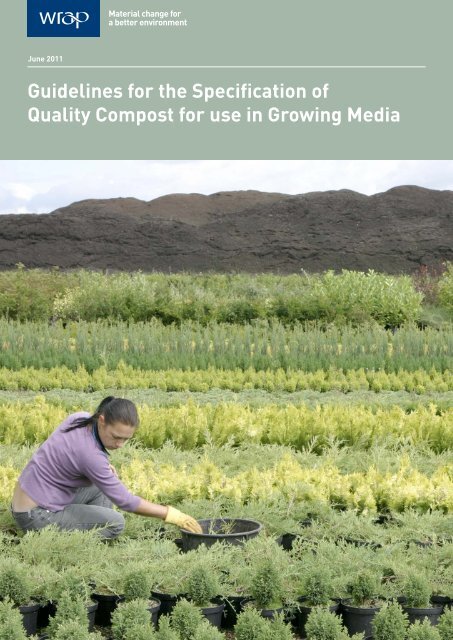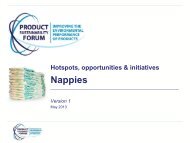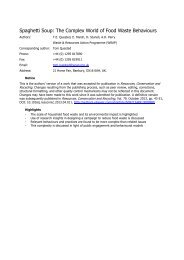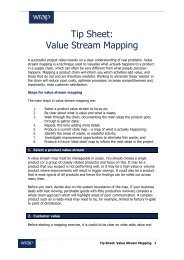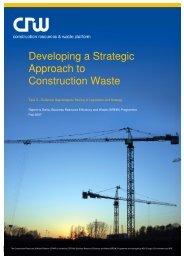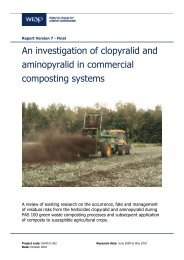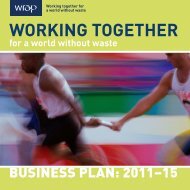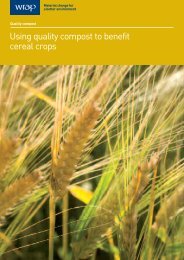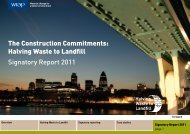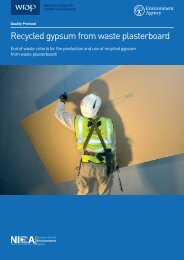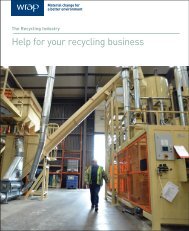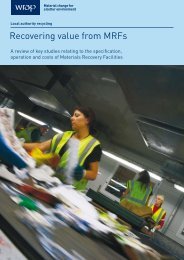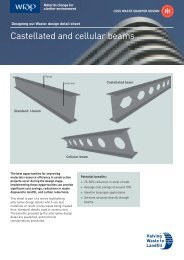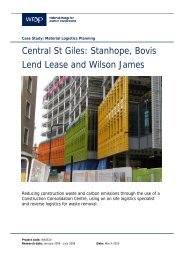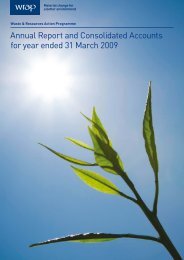Guidelines for the Specification of Quality Compost for use in ... - Wrap
Guidelines for the Specification of Quality Compost for use in ... - Wrap
Guidelines for the Specification of Quality Compost for use in ... - Wrap
Create successful ePaper yourself
Turn your PDF publications into a flip-book with our unique Google optimized e-Paper software.
<strong>Guidel<strong>in</strong>es</strong> <strong>for</strong> <strong>the</strong> <strong>Specification</strong> <strong>of</strong> <strong>Quality</strong> <strong>Compost</strong> <strong>for</strong> <strong>use</strong> <strong>in</strong> Grow<strong>in</strong>g Media 1<br />
June 2011<br />
<strong>Guidel<strong>in</strong>es</strong> <strong>for</strong> <strong>the</strong> <strong>Specification</strong> <strong>of</strong><br />
<strong>Quality</strong> <strong>Compost</strong> <strong>for</strong> <strong>use</strong> <strong>in</strong> Grow<strong>in</strong>g Media
<strong>Guidel<strong>in</strong>es</strong> <strong>for</strong> <strong>the</strong> <strong>Specification</strong> <strong>of</strong> <strong>Quality</strong> <strong>Compost</strong> <strong>for</strong> <strong>use</strong> <strong>in</strong> Grow<strong>in</strong>g Media 2<br />
OUR VISION:<br />
A world without waste, where<br />
resources are <strong>use</strong>d susta<strong>in</strong>ably.<br />
OUR MISSION:<br />
To help bus<strong>in</strong>esses and <strong>in</strong>dividuals<br />
reap <strong>the</strong> benefits <strong>of</strong> reduc<strong>in</strong>g<br />
waste, develop<strong>in</strong>g susta<strong>in</strong>able<br />
products and us<strong>in</strong>g resources<br />
<strong>in</strong> an efficient way.<br />
1.0 Introduction 4<br />
1.1 Fundamental qualities <strong>of</strong> a compost to be <strong>use</strong>d<br />
as a component <strong>of</strong> a grow<strong>in</strong>g medium 5<br />
2.0 Permitted and prohibited <strong>in</strong>gredients 6<br />
3.0 Product declaration and laboratory report 7<br />
4.0 Sampl<strong>in</strong>g and frequency <strong>of</strong> analysis 7<br />
5.0 Product liability 8<br />
6.0 <strong>Quality</strong> parameters 9<br />
7.0 Additional <strong>in</strong><strong>for</strong>mation 12<br />
8.0 Suggested rates <strong>of</strong> <strong>use</strong> <strong>of</strong> compost 13<br />
9.0 Fur<strong>the</strong>r sources <strong>of</strong> <strong>in</strong><strong>for</strong>mation 13
<strong>Guidel<strong>in</strong>es</strong> <strong>for</strong> <strong>the</strong> <strong>Specification</strong> <strong>of</strong> <strong>Quality</strong> <strong>Compost</strong> <strong>for</strong> <strong>use</strong> <strong>in</strong> Grow<strong>in</strong>g Media 3<br />
<strong>Guidel<strong>in</strong>es</strong> <strong>for</strong> <strong>the</strong> <strong>Specification</strong> <strong>of</strong> <strong>Quality</strong> <strong>Compost</strong><br />
<strong>for</strong> <strong>use</strong> <strong>in</strong> Grow<strong>in</strong>g Media<br />
These guidel<strong>in</strong>es have been written to help composters who want to supply <strong>the</strong> horticultural<br />
grow<strong>in</strong>g media market meet <strong>the</strong> quality standards required by this sector. They have been<br />
produced by ADAS , Earthcare and WRAP <strong>in</strong> consultation with <strong>the</strong> grow<strong>in</strong>g media sector,<br />
compost<strong>in</strong>g <strong>in</strong>dustry, and <strong>the</strong> Association <strong>for</strong> Organics Recycl<strong>in</strong>g (AfOR). The guidel<strong>in</strong>es<br />
will help a composter manufacture compost with <strong>the</strong> most suitable characteristics <strong>for</strong> <strong>use</strong><br />
<strong>in</strong> grow<strong>in</strong>g media. They are not <strong>in</strong>tended to be prescriptive; <strong>the</strong> actual detailed specification<br />
<strong>for</strong> compost will need to be agreed with <strong>the</strong> grow<strong>in</strong>g media manufacturer or grower who<br />
is purchas<strong>in</strong>g <strong>the</strong> compost, and will depend on <strong>the</strong> types <strong>of</strong> plants to be grown <strong>in</strong> <strong>the</strong> mix it<br />
is <strong>use</strong>d <strong>for</strong>. <strong>Quality</strong> compost is already be<strong>in</strong>g <strong>use</strong>d as a constituent <strong>of</strong> many retail grow<strong>in</strong>g<br />
media products (<strong>for</strong> example <strong>in</strong> reduced peat/peat free ‘multi-purpose compost’ and ‘grow<br />
bags’) and is also be<strong>in</strong>g successfully <strong>use</strong>d by some pr<strong>of</strong>essional growers, particularly <strong>for</strong><br />
hardy ornamental plants.<br />
Only <strong>the</strong> highest quality composts with consistent physical, chemical and biological<br />
characteristics are suitable <strong>for</strong> <strong>use</strong> <strong>in</strong> horticultural grow<strong>in</strong>g media and this document <strong>of</strong>fers<br />
guidance on <strong>the</strong> properties <strong>of</strong> suitable composts. Regulatory requirements should always be<br />
adhered to and are subject to change. <strong>Compost</strong>ers/manufacturers/<strong>use</strong>rs should ensure that<br />
<strong>the</strong>y are always up to date with current regulatory requirements. All composts dest<strong>in</strong>ed <strong>for</strong><br />
<strong>use</strong> <strong>in</strong> grow<strong>in</strong>g media should be produced and <strong>use</strong>d <strong>in</strong> accordance with current regulations<br />
and already be produced <strong>in</strong> accordance with <strong>the</strong> requirements <strong>of</strong> BSI PAS 100 and <strong>the</strong> <strong>Compost</strong><br />
<strong>Quality</strong> Protocol (<strong>the</strong> latter is not applicable <strong>in</strong> Scotland).<br />
The <strong>Compost</strong> <strong>Quality</strong> Protocol (CQP) was launched <strong>in</strong> 2008. It def<strong>in</strong>es when compost is<br />
considered a product, and no longer falls under <strong>the</strong> waste management regulations. One <strong>of</strong><br />
<strong>the</strong> requirements <strong>of</strong> <strong>the</strong> CQP is that composts are produced to a recognised standard e.g. BSI<br />
PAS 100. (NB. Compliance with <strong>the</strong> <strong>Compost</strong> <strong>Quality</strong> Protocol is not required <strong>in</strong> Scotland at<br />
<strong>the</strong> time <strong>of</strong> publication however as part <strong>of</strong> Scotland’s end <strong>of</strong> waste position statement, SEPA<br />
requires that compost is produced to BSI PAS 100).
<strong>Guidel<strong>in</strong>es</strong> <strong>for</strong> <strong>the</strong> <strong>Specification</strong> <strong>of</strong> <strong>Quality</strong> <strong>Compost</strong> <strong>for</strong> <strong>use</strong> <strong>in</strong> Grow<strong>in</strong>g Media 4<br />
1.0 Introduction<br />
High quality composted materials made from source-segregated biodegradable feedstocks<br />
can be <strong>use</strong>ful <strong>in</strong>gredients <strong>in</strong> peat-free or reduced peat grow<strong>in</strong>g media. There are a number <strong>of</strong><br />
advantages <strong>of</strong> us<strong>in</strong>g compost <strong>in</strong> a grow<strong>in</strong>g medium:<br />
• compost provides major and m<strong>in</strong>or nutrients and <strong>in</strong>creases chemical buffer<strong>in</strong>g and water<br />
hold<strong>in</strong>g capacity <strong>in</strong> <strong>the</strong> grow<strong>in</strong>g medium <strong>in</strong> a similar way to loam;<br />
• compost may assist <strong>in</strong> <strong>the</strong> suppression <strong>of</strong> some plant diseases beca<strong>use</strong> it is more<br />
biologically active than o<strong>the</strong>r grow<strong>in</strong>g media constituents; and<br />
• compost may reduce <strong>the</strong> growth <strong>of</strong> liverworts, moss and algae when <strong>use</strong>d <strong>in</strong> blends that<br />
reta<strong>in</strong> a drier surface than 100% peat mixes.<br />
However, beca<strong>use</strong> <strong>of</strong> its naturally high nutrient levels and relatively high bulk density, rates<br />
<strong>of</strong> compost <strong>in</strong>clusion <strong>in</strong> a grow<strong>in</strong>g medium are limited (usually to a maximum <strong>of</strong> 40-50%<br />
by volume) and <strong>the</strong>re<strong>for</strong>e <strong>the</strong> compost must be blended with an appropriate low nutrient/<br />
low bulk density material such as peat, bark or coir fibre. For pr<strong>of</strong>essional growers it is<br />
essential <strong>for</strong> new grow<strong>in</strong>g media conta<strong>in</strong><strong>in</strong>g compost to be trialled on a small scale first on <strong>the</strong><br />
nursery, <strong>in</strong> <strong>the</strong> same way as any o<strong>the</strong>r new grow<strong>in</strong>g media <strong>for</strong>mulation is trialled be<strong>for</strong>e be<strong>in</strong>g<br />
<strong>in</strong>troduced and <strong>use</strong>d more generally. This is also necessary as different grow<strong>in</strong>g media need<br />
specific water<strong>in</strong>g and feed<strong>in</strong>g regimes, so crop management strategies need to be matched<br />
accord<strong>in</strong>gly.<br />
Grow<strong>in</strong>g media are handled by both <strong>the</strong> garden<strong>in</strong>g public and workers on nurseries and<br />
<strong>the</strong>re<strong>for</strong>e any <strong>in</strong>gredients <strong>use</strong>d <strong>in</strong> <strong>the</strong>m must be safe from a human health po<strong>in</strong>t <strong>of</strong> view.<br />
Material free from human pathogens and any glass or sharp material is <strong>the</strong>re<strong>for</strong>e essential.<br />
Contam<strong>in</strong>ants such as plastic, whilst not dangerous, are also undesirable beca<strong>use</strong> <strong>the</strong> visual<br />
appearance <strong>of</strong> <strong>the</strong> end product is important.<br />
The end <strong>use</strong> <strong>of</strong> <strong>the</strong> grow<strong>in</strong>g medium must be taken <strong>in</strong>to account when us<strong>in</strong>g compost as an<br />
<strong>in</strong>gredient. Crops which are sensitive to high pH and/or high Electrical Conductivity (EC)<br />
(<strong>for</strong> example seedl<strong>in</strong>gs and ericaceous species such as Azalea and Rhododendron) are less<br />
suited to compost <strong>in</strong>clusion than more vigorous general shrubs. Crops grown to schedule and<br />
str<strong>in</strong>gent supermarket specifications are also <strong>in</strong> a higher risk category (<strong>for</strong> example <strong>in</strong>door<br />
pot plants). General shrubs and trees grown <strong>for</strong> landscap<strong>in</strong>g have less str<strong>in</strong>gent quality<br />
control than o<strong>the</strong>r horticulture applications and may be more suited to compost <strong>use</strong>. The slow<br />
release nutrients provided by compost can be beneficial <strong>for</strong> <strong>the</strong>se longer term crops.<br />
The British Standards Institution’s Publicly Available <strong>Specification</strong> 100 (commonly referred<br />
to as PAS 100) <strong>for</strong> composted materials was developed by WRAP <strong>in</strong> conjunction with <strong>the</strong><br />
Association <strong>for</strong> Organics Recycl<strong>in</strong>g (AfOR) and BSI, launched <strong>in</strong> 2002 it has been updated<br />
regularly s<strong>in</strong>ce <strong>the</strong>n. It acts as a basel<strong>in</strong>e specification which covers <strong>the</strong> entire production<br />
process <strong>for</strong> composts and which assures that compost is produced to a level <strong>of</strong> consistency,<br />
reliability and safety laid down by <strong>the</strong> specification.
<strong>Guidel<strong>in</strong>es</strong> <strong>for</strong> <strong>the</strong> <strong>Specification</strong> <strong>of</strong> <strong>Quality</strong> <strong>Compost</strong> <strong>for</strong> <strong>use</strong> <strong>in</strong> Grow<strong>in</strong>g Media 5<br />
1.0 Introduction cont.<br />
BSI PAS 100 is a basel<strong>in</strong>e specification and <strong>the</strong> result<strong>in</strong>g composts are suitable <strong>for</strong> a range<br />
<strong>of</strong> markets <strong>in</strong> addition to horticulture. It does not <strong>the</strong>re<strong>for</strong>e set limits <strong>for</strong> all characteristics<br />
required by specific horticultural end <strong>use</strong>rs such as grow<strong>in</strong>g media manufacturers. The<br />
guidel<strong>in</strong>es <strong>in</strong> this document are an update <strong>of</strong> those previously published by WRAP <strong>in</strong> 2004<br />
(<strong>Guidel<strong>in</strong>es</strong> <strong>for</strong> <strong>the</strong> specification <strong>of</strong> composted green materials <strong>use</strong>d as a grow<strong>in</strong>g media<br />
component). They are designed to assist producers <strong>of</strong> composted green materials to better<br />
understand and meet <strong>the</strong> specific requirements <strong>for</strong> composts to be <strong>use</strong>d <strong>in</strong> grow<strong>in</strong>g media.<br />
They have been developed <strong>in</strong> partnership with key stakeholders, <strong>in</strong>clud<strong>in</strong>g grow<strong>in</strong>g media<br />
manufacturers and compost producers, with <strong>in</strong>put from <strong>the</strong> AfOR and o<strong>the</strong>r experts. They are<br />
guidel<strong>in</strong>es only and a compost producer will need to agree exact specifications <strong>for</strong> compost<br />
products with <strong>the</strong> customer. For <strong>the</strong> production <strong>of</strong> food crops, human health standards set by<br />
<strong>the</strong> retailer or farm assurance scheme may be more str<strong>in</strong>gent than those set out <strong>in</strong> this guide<br />
and should also be referred to.<br />
One basic physical grade is specified here<strong>in</strong> (0-10 mm) and composted material meet<strong>in</strong>g <strong>the</strong>se<br />
general guidel<strong>in</strong>es is expected to be suitable <strong>for</strong> a wide range <strong>of</strong> applications. However, <strong>for</strong><br />
some specific applications such as grow<strong>in</strong>g media <strong>for</strong> longer-term crops such as nursery<br />
stock <strong>in</strong> larger conta<strong>in</strong>ers, a proportion <strong>of</strong> coarser grade material might be more appropriate.<br />
Similarly, f<strong>in</strong>er grades <strong>of</strong> compost may be required <strong>for</strong> production <strong>of</strong> seedl<strong>in</strong>gs or cutt<strong>in</strong>gs <strong>in</strong><br />
small modules. Particle size specification should be set by <strong>the</strong> customer and agreed prior to<br />
delivery.<br />
1.1 Fundamental qualities <strong>of</strong> a compost to be <strong>use</strong>d as a component <strong>of</strong> a grow<strong>in</strong>g medium<br />
For compost to be suitable <strong>for</strong> <strong>the</strong> horticultural market it must be:<br />
a. Produced only from approved feedstocks <strong>in</strong> accordance with <strong>the</strong> standards set out <strong>in</strong><br />
<strong>the</strong> <strong>Compost</strong> <strong>Quality</strong> Protocol/PAS 100:2011 tak<strong>in</strong>g <strong>in</strong>to account <strong>the</strong> exclusions listed <strong>in</strong><br />
section 2.<br />
b. <strong>Compost</strong> <strong>Quality</strong> Protocol compliant (not required <strong>in</strong> Scotland).<br />
c. Sanitised, stable and mature, as def<strong>in</strong>ed <strong>in</strong> PAS100:2011 and detailed <strong>in</strong> section 6 <strong>of</strong> <strong>the</strong><br />
guidel<strong>in</strong>es.<br />
d. Free from all ‘sharps’ (as def<strong>in</strong>ed <strong>in</strong> PAS 100:2011).<br />
e. Free from materials, contam<strong>in</strong>ants, weeds, pathogens, pesticides/herbicides or<br />
potentially toxic elements (PTEs) that may adversely affect <strong>the</strong> <strong>use</strong>r, equipment or plant<br />
growth.<br />
f. Acceptable to <strong>the</strong> customer <strong>in</strong> appearance and odour.<br />
g. Free-flow<strong>in</strong>g and friable and nei<strong>the</strong>r wet and sticky nor dry and dusty.<br />
h. Acceptable <strong>in</strong> physical and chemical properties, as def<strong>in</strong>ed <strong>in</strong> PAS100:2011 and <strong>in</strong> section<br />
6 <strong>of</strong> <strong>the</strong> guidel<strong>in</strong>es.
<strong>Guidel<strong>in</strong>es</strong> <strong>for</strong> <strong>the</strong> <strong>Specification</strong> <strong>of</strong> <strong>Quality</strong> <strong>Compost</strong> <strong>for</strong> <strong>use</strong> <strong>in</strong> Grow<strong>in</strong>g Media 6<br />
2.0 Permitted and prohibited <strong>in</strong>gredients<br />
<strong>Compost</strong>ed materials as def<strong>in</strong>ed <strong>in</strong> <strong>the</strong>se guidel<strong>in</strong>es shall be made from source separated<br />
feedstocks as def<strong>in</strong>ed <strong>in</strong> <strong>the</strong> CQP/PAS 100:2011, such as green wastes from parks and<br />
gardens.<br />
Prohibited <strong>in</strong>gredients:<br />
a. Sewage sludge.<br />
b. Mixed municipal waste (unseparated domestic waste from dustb<strong>in</strong>s etc.).<br />
c. Post-consumer wood waste (e.g. w<strong>in</strong>dow frames and o<strong>the</strong>r demolition waste that may be<br />
contam<strong>in</strong>ated with metal, glass and PTEs).<br />
With <strong>the</strong> full knowledge and prior written agreement <strong>of</strong> <strong>the</strong> purchaser, compost might <strong>in</strong>clude<br />
food wastes that have been composted to <strong>the</strong> standards set <strong>in</strong> <strong>the</strong> Animal By-products<br />
Regulations (ABPR). Inclusion <strong>of</strong> food waste may <strong>in</strong>crease <strong>the</strong> electrical conductivity <strong>of</strong> <strong>the</strong><br />
f<strong>in</strong>ished compost and <strong>in</strong> practice <strong>the</strong> rate <strong>of</strong> <strong>in</strong>clusion <strong>of</strong> such materials should <strong>the</strong>re<strong>for</strong>e be<br />
limited to a low percentage (
<strong>Guidel<strong>in</strong>es</strong> <strong>for</strong> <strong>the</strong> <strong>Specification</strong> <strong>of</strong> <strong>Quality</strong> <strong>Compost</strong> <strong>for</strong> <strong>use</strong> <strong>in</strong> Grow<strong>in</strong>g Media 7<br />
3.0 Product declaration and laboratory report<br />
Each batch <strong>of</strong> compost supplied <strong>for</strong> <strong>use</strong> <strong>in</strong> grow<strong>in</strong>g media must be clearly identifiable and<br />
traceable <strong>in</strong> l<strong>in</strong>e with BSI PAS 100:2011 requirements.<br />
A ‘batch’ is def<strong>in</strong>ed as a quantity <strong>of</strong> composted material, produced from <strong>the</strong> same <strong>in</strong>put<br />
materials, by <strong>the</strong> same methods and under <strong>the</strong> same conditions over a set period <strong>of</strong> time and<br />
hav<strong>in</strong>g <strong>the</strong> same properties.<br />
The supplier should also provide <strong>the</strong> follow<strong>in</strong>g data:<br />
• A full declaration <strong>of</strong> <strong>the</strong> physical and chemical properties <strong>of</strong> <strong>the</strong> compost (as listed <strong>in</strong><br />
section 6).<br />
• A laboratory report on a representative sample from <strong>the</strong> batch* that demonstrates that<br />
<strong>the</strong> properties described are with<strong>in</strong> <strong>the</strong> ranges (limits) specified.<br />
* <strong>the</strong> sampl<strong>in</strong>g frequency to be agreed with <strong>the</strong> customer. It may be less than a one per batch basis <strong>for</strong> some<br />
parameters. In such cases <strong>the</strong> composter will make available representative data based upon <strong>the</strong>ir sampl<strong>in</strong>g history.<br />
If <strong>the</strong> result <strong>for</strong> one or more parameters is outside <strong>the</strong> specified limits, <strong>the</strong> customer should<br />
be <strong>in</strong><strong>for</strong>med immediately and given <strong>the</strong> opportunity to reject <strong>the</strong> batch prior to delivery.<br />
4.0 Sampl<strong>in</strong>g and frequency <strong>of</strong> analysis<br />
<strong>Compost</strong> batches should be sampled and tested after any screen<strong>in</strong>g that produces <strong>the</strong> f<strong>in</strong>al<br />
product grade and as close to <strong>the</strong> time <strong>of</strong> distribution as possible. It should be remembered<br />
that <strong>the</strong> turn-around time <strong>for</strong> <strong>the</strong> <strong>in</strong>tegrated plant response and weeds test is at least 6 weeks.<br />
The date <strong>of</strong> sampl<strong>in</strong>g should be stated on <strong>the</strong> results sheet.<br />
Proper sampl<strong>in</strong>g, preparation and storage <strong>of</strong> <strong>the</strong> f<strong>in</strong>al sample are vital and <strong>the</strong>se must be<br />
carried out <strong>in</strong> accordance with <strong>the</strong> procedure set out <strong>in</strong> BS EN 12579:2000. This standard<br />
specifies that <strong>for</strong> a batch <strong>of</strong> bulk material <strong>of</strong> up to 5,000 cubic metres, <strong>the</strong> m<strong>in</strong>imum number <strong>of</strong><br />
<strong>in</strong>cremental sampl<strong>in</strong>g po<strong>in</strong>ts is 12 and <strong>the</strong> number <strong>in</strong>creases as <strong>the</strong> batch volume <strong>in</strong>creases,<br />
up to a maximum <strong>of</strong> 30 <strong>in</strong>cremental sampl<strong>in</strong>g po<strong>in</strong>ts. For example, <strong>for</strong> a batch <strong>of</strong> 1,000 cubic<br />
metres <strong>the</strong> prescribed number <strong>of</strong> sampl<strong>in</strong>g po<strong>in</strong>ts is 16 and it is recommended that this<br />
number is adopted as a standard <strong>for</strong> batches <strong>of</strong> less than 1,000 cubic metres as well. The<br />
<strong>in</strong>cremental samples from each sampl<strong>in</strong>g po<strong>in</strong>t must be comb<strong>in</strong>ed toge<strong>the</strong>r and thoroughly<br />
homogenised be<strong>for</strong>e a representative portion is taken as <strong>the</strong> f<strong>in</strong>al sample <strong>for</strong> analysis.<br />
All analyses should be carried out by a competent and AfOR approved laboratory. Any<br />
prelim<strong>in</strong>ary on-site test<strong>in</strong>g (such as with a Solvita® kit <strong>for</strong> check<strong>in</strong>g compost stability/<br />
maturity) must be carried out by a suitably tra<strong>in</strong>ed <strong>in</strong>dividual.<br />
The frequency <strong>of</strong> sampl<strong>in</strong>g should be agreed with <strong>the</strong> customer, however <strong>the</strong> absolute<br />
m<strong>in</strong>imum frequency <strong>of</strong> analysis <strong>for</strong> all parameters should be a m<strong>in</strong>imum <strong>of</strong> ei<strong>the</strong>r one analysis<br />
per 5000m 3 <strong>of</strong> screened compost produced or one analysis every 6 months, whichever occurs<br />
sooner (Note: <strong>the</strong> m<strong>in</strong>imum frequency <strong>of</strong> analysis <strong>for</strong> each parameter required by BSI PAS 100<br />
(post validation) is once every 5000m 3 or once every 12 months, whichever occurs sooner).
<strong>Guidel<strong>in</strong>es</strong> <strong>for</strong> <strong>the</strong> <strong>Specification</strong> <strong>of</strong> <strong>Quality</strong> <strong>Compost</strong> <strong>for</strong> <strong>use</strong> <strong>in</strong> Grow<strong>in</strong>g Media 8<br />
5.0 Product liability<br />
The supply <strong>of</strong> compost as a grow<strong>in</strong>g media <strong>in</strong>gredient is subject to <strong>the</strong> normal contractual and<br />
legal obligations <strong>in</strong> respect <strong>of</strong> product liability. Accord<strong>in</strong>gly, <strong>the</strong> follow<strong>in</strong>g basic po<strong>in</strong>ts should<br />
be noted.<br />
a. It is <strong>the</strong> responsibility <strong>of</strong> <strong>the</strong> compost supplier to assure <strong>the</strong> customer that <strong>the</strong> material<br />
supplied meets <strong>the</strong> agreed purchas<strong>in</strong>g specification and is sourced, processed and stored<br />
appropriately.<br />
b. It is <strong>the</strong> responsibility <strong>of</strong> <strong>the</strong> purchaser and grow<strong>in</strong>g media manufacturer/<strong>for</strong>mulator to<br />
determ<strong>in</strong>e <strong>the</strong> appropriate rate <strong>of</strong> <strong>use</strong> <strong>of</strong> compost <strong>in</strong> a grow<strong>in</strong>g medium <strong>for</strong> a particular<br />
application.<br />
c. The composter must ensure that <strong>the</strong> appropriate labell<strong>in</strong>g <strong>in</strong><strong>for</strong>mation, <strong>in</strong>clud<strong>in</strong>g safe <strong>use</strong><br />
<strong>in</strong>structions required by PAS 100, is given to customers. AfOR require <strong>in</strong><strong>for</strong>mation and<br />
safe handl<strong>in</strong>g <strong>in</strong><strong>for</strong>mation to be provided as part <strong>of</strong> <strong>the</strong>ir PAS 100 accreditation scheme.<br />
Appropriate labell<strong>in</strong>g should be made clear at all stages <strong>of</strong> <strong>the</strong> supply cha<strong>in</strong> through to<br />
end <strong>use</strong>r.
<strong>Guidel<strong>in</strong>es</strong> <strong>for</strong> <strong>the</strong> <strong>Specification</strong> <strong>of</strong> <strong>Quality</strong> <strong>Compost</strong> <strong>for</strong> <strong>use</strong> <strong>in</strong> Grow<strong>in</strong>g Media 9<br />
6.0 <strong>Quality</strong> parameters<br />
This section gives recommended targets and limits <strong>for</strong> <strong>the</strong> ma<strong>in</strong> quality parameters <strong>of</strong><br />
composted material that is to be <strong>use</strong>d as a grow<strong>in</strong>g medium constituent. The actual<br />
specifications required will depend on <strong>the</strong> type <strong>of</strong> plants be<strong>in</strong>g grown <strong>in</strong> <strong>the</strong> grow<strong>in</strong>g<br />
medium, <strong>the</strong> rate <strong>of</strong> <strong>in</strong>clusion <strong>of</strong> <strong>the</strong> compost and <strong>the</strong> physical and chemical nature <strong>of</strong> o<strong>the</strong>r<br />
constituents be<strong>in</strong>g <strong>use</strong>d <strong>in</strong> <strong>the</strong> grow<strong>in</strong>g media. Depend<strong>in</strong>g on <strong>the</strong> actual analytical values <strong>for</strong><br />
any batch and its <strong>in</strong>tended application, <strong>the</strong> appropriate rates <strong>of</strong> <strong>use</strong> may be as low as 5% but<br />
could be up to 40-50%. The grow<strong>in</strong>g media <strong>for</strong>mulator must evaluate <strong>the</strong> suitability <strong>of</strong> any<br />
particular source <strong>of</strong> composted green material and must determ<strong>in</strong>e <strong>the</strong> appropriate limits and<br />
rate <strong>of</strong> <strong>use</strong> accord<strong>in</strong>g to technical and commercial factors.<br />
Stability and Maturity<br />
Parameter Test method Units Target Upper Limit Comments<br />
CO2<br />
evolution<br />
test<br />
ORG0020<br />
method<br />
mg CO2/g<br />
organic<br />
matter/day<br />
8 10 PAS 100:2011 limit is 16 but a more<br />
stable compost is needed <strong>for</strong> grow<strong>in</strong>g<br />
media <strong>use</strong>s. A lower value <strong>in</strong>dicates<br />
greater stability.<br />
Solvita® test<br />
(optional but<br />
<strong>use</strong>ful)<br />
On site<br />
test<strong>in</strong>g*<br />
CO2 Score 8 7 or 8 (8 is<br />
max score<br />
achievable<br />
<strong>for</strong> this test)<br />
A CO2 Score <strong>of</strong> 6 is thought to be<br />
equivalent to <strong>the</strong> PAS 100:2010 limit.<br />
A higher value <strong>in</strong>dicates greater<br />
stability.<br />
*Note: Staff carry<strong>in</strong>g out Solvita test<strong>in</strong>g on site must be suitably tra<strong>in</strong>ed.<br />
Phytotoxicity<br />
Parameter Test method Units Target Limits Comments<br />
Bioassay<br />
<strong>for</strong> <strong>the</strong><br />
presence <strong>of</strong><br />
phytotox<strong>in</strong>s<br />
such as<br />
pesticides<br />
and<br />
herbicide<br />
residues<br />
OFW006-000,<br />
OFW004-006,<br />
as specified<br />
<strong>in</strong> PAS<br />
100:2010 100:2011<br />
Scor<strong>in</strong>g<br />
v. known<br />
control<br />
Germ<strong>in</strong>ation<br />
and average<br />
plant mass<br />
80% or<br />
higher than<br />
control<br />
Per<strong>for</strong>mance<br />
at least 80%<br />
<strong>of</strong> control<br />
plus zero<br />
distortion <strong>of</strong><br />
growth<br />
Germ<strong>in</strong>ation should be unaffected<br />
and growth normal. Shoots<br />
and leaves should exhibit no<br />
distortions, lesions, chlorosis or<br />
o<strong>the</strong>r abnormalities under <strong>the</strong> test<br />
conditions.<br />
Bioassay <strong>for</strong><br />
presence <strong>of</strong><br />
herbicide<br />
residues (if<br />
(if required by<br />
by customer<br />
or if a<br />
higher risk<br />
feedstock)<br />
OFW006- OFW004-006<br />
000 and/or<br />
Dow Bean<br />
bioassay*<br />
Scor<strong>in</strong>g<br />
v. known<br />
control<br />
No growth<br />
dis-tortion distortion<br />
and as above<br />
<strong>for</strong> OFW006-<br />
000 OFW004-006<br />
As above.<br />
* Note: The most recent validated bioassay method should be <strong>use</strong>d and agreed with <strong>the</strong> end <strong>use</strong>r. A new CEN method is expected to be available <strong>in</strong><br />
<strong>the</strong> near future.
<strong>Guidel<strong>in</strong>es</strong> <strong>for</strong> <strong>the</strong> <strong>Specification</strong> <strong>of</strong> <strong>Quality</strong> <strong>Compost</strong> <strong>for</strong> <strong>use</strong> <strong>in</strong> Grow<strong>in</strong>g Media 10<br />
Contam<strong>in</strong>ants and Pathogens<br />
Parameter Test method Units Target Upper limit Comments<br />
Weed<br />
seeds and<br />
propagules<br />
OFW004-006,<br />
as specified<br />
<strong>in</strong> PAS<br />
100:2011<br />
Number<br />
per litre <strong>of</strong><br />
compost<br />
Absent Zero No live plant material shall be visible<br />
on delivery.<br />
Sharps<br />
AfOR MT<br />
PC&S<br />
Present or<br />
absent<br />
Absent Zero Physical contam<strong>in</strong>ants that are sharp<br />
are unacceptable <strong>in</strong> any application<br />
where compost is handled and/or<br />
<strong>use</strong>d <strong>in</strong> grow<strong>in</strong>g media.<br />
Stones<br />
As specified<br />
<strong>in</strong> PAS<br />
100:2011,<br />
AfOR MT<br />
PC&S<br />
%weight/<br />
weight dry<br />
matter<br />
reta<strong>in</strong>ed on<br />
lab. sieves<br />
Absent<br />
2 % stones <strong>of</strong><br />
> 4 mm, no<br />
stones > 8<br />
mm<br />
None > 4 mm shall be found on<br />
visual <strong>in</strong>spection at delivery.<br />
Metal, glass<br />
and plastic<br />
> 2 mm*<br />
As specified<br />
<strong>in</strong> PAS<br />
100:2011<br />
% w/w dry<br />
matter<br />
reta<strong>in</strong>ed on<br />
lab. sieves<br />
Absent<br />
0.2 % metal<br />
0.05 % plastic<br />
0.1 % glass<br />
None > 2 mm should be found on<br />
visual <strong>in</strong>spection at delivery and a<br />
s<strong>in</strong>gle presence suggests potential<br />
non-compliance.<br />
*See note below <strong>for</strong> <strong>the</strong> overall PAS<br />
100 total limit <strong>for</strong> glass, metal and<br />
plastic and any “o<strong>the</strong>r” non stone<br />
fragments.<br />
Salmonella<br />
spp.<br />
BS EN ISO<br />
6579<br />
n/25 g<br />
fresh weight<br />
Absent Zero Limit as per PAS 100:2011.<br />
E. coli BS ISO<br />
16649-2<br />
cfu/g fresh<br />
weight<br />
Absent 1000** Limit as per PAS 100:2011.<br />
*Note: Despite <strong>the</strong> <strong>in</strong>dividual limits above, <strong>the</strong> overall limit <strong>in</strong> PAS 100 that must be adhered to <strong>for</strong> “Total glass, metal and plastic and any<br />
“o<strong>the</strong>r” non stone fragments > 2mm” is 0.25%. PAS 100 also requires <strong>the</strong> total level <strong>of</strong> plastic > 2mm to be no more than 0.12%, however<br />
this guide recommends that plastic > 2mm should be no more than 0.05%”.<br />
**Note: The reduction <strong>of</strong> <strong>in</strong>digenous E. coli to this level <strong>in</strong>dicates <strong>the</strong> likelihood that o<strong>the</strong>r human pathogens such as Campylobacter<br />
are elim<strong>in</strong>ated.<br />
Potentially Toxic Elements<br />
Parameter Test method Units Target Upper Limit Comments<br />
Cadmium<br />
(Cd)<br />
BS EN 13650<br />
mg/kg dry<br />
matter<br />
< 0.5 1.5 Limit as per PAS 100:2011.<br />
Chromium<br />
(Cr)<br />
BS EN 13650<br />
mg/kg dry<br />
matter<br />
< 50 100 Limit as per PAS 100:2011.<br />
Copper (Cu) BS EN 13650 mg/kg dry<br />
matter<br />
Lead (Pb) BS EN 13650 mg/kg dry<br />
matter<br />
< 50 200 Limit as per PAS 100:2011.<br />
< 50 200 Limit as per PAS 100:2011.<br />
Mercury<br />
(Hg)<br />
ISO/DIS<br />
16772<br />
mg/kg dry<br />
matter<br />
< 0.5 1.0 Limit as per PAS 100:2011.<br />
Nickel (Ni) BS EN 13650 mg/kg dry<br />
matter<br />
Z<strong>in</strong>c (Zn) BS EN 13650 mg/kg dry<br />
matter<br />
< 50 50 Limit as per PAS 100:2011.<br />
< 150 400 Limit as per PAS 100:2011.
<strong>Guidel<strong>in</strong>es</strong> <strong>for</strong> <strong>the</strong> <strong>Specification</strong> <strong>of</strong> <strong>Quality</strong> <strong>Compost</strong> <strong>for</strong> <strong>use</strong> <strong>in</strong> Grow<strong>in</strong>g Media 11<br />
Physical and Chemical Properties<br />
Parameter Test method Units Target value<br />
or range<br />
Upper limit<br />
Comments<br />
Bulk density<br />
(BD)<br />
BS EN 12580<br />
g/l (fresh<br />
weight)<br />
400-500 550 Should be as near to 400 as possible.<br />
Particle size<br />
distribution<br />
(0-10 mm<br />
grade)<br />
As specified<br />
<strong>in</strong> PAS<br />
100:2011<br />
% w/w dry<br />
matter<br />
reta<strong>in</strong>ed on<br />
lab. sieves<br />
0 % > 8 mm* To be<br />
agreed with<br />
customer<br />
Target is <strong>for</strong> general, multipurpose<br />
<strong>use</strong> but customer may wish to<br />
specify o<strong>the</strong>r grades. (*Sieve sizes<br />
<strong>for</strong> PAS100 are 31.5mm, 16mm,8mm,<br />
4mm,2mm and 1mm).<br />
Moisture<br />
content at<br />
despatch<br />
BS EN 13040<br />
% w/w<br />
(fresh<br />
weight)<br />
35-40 50 Should be low at despatch to<br />
m<strong>in</strong>imise bulk density.<br />
pH BS EN 13037 None 6.0–8.0 9.0 Lower levels needed <strong>for</strong> acid lov<strong>in</strong>g<br />
plants (mixes <strong>for</strong> such plants would<br />
not <strong>in</strong>clude high rates <strong>of</strong> compost<br />
anyway).<br />
Electrical<br />
conductivity<br />
(EC) <strong>in</strong><br />
1:5 water<br />
extract<br />
BS EN 13038 µS/cm < 600 1500 May need to be lower EC if compost<br />
to be <strong>use</strong>d at higher <strong>in</strong>clusion rate or<br />
<strong>for</strong> sensitive species.<br />
NH4-N BS EN 13652 mg/l (as<br />
received)<br />
< 40 50 As low as possible and below <strong>the</strong><br />
NO3-N (nitrate-N) level.<br />
Sodium (Na)<br />
<strong>in</strong> water<br />
extract<br />
BS EN 13652<br />
mg/l (as<br />
received)<br />
< 100 150 Associated with Cl so will be high if<br />
Cl is high.<br />
Chloride<br />
(Cl) <strong>in</strong> water<br />
extract<br />
BS EN 13652<br />
mg/l (as<br />
received)<br />
< 500 1000 Influences EC. Lower levels needed<br />
<strong>for</strong> more sensitive applications, e.g.<br />
young plants and ericaceous species.
<strong>Guidel<strong>in</strong>es</strong> <strong>for</strong> <strong>the</strong> <strong>Specification</strong> <strong>of</strong> <strong>Quality</strong> <strong>Compost</strong> <strong>for</strong> <strong>use</strong> <strong>in</strong> Grow<strong>in</strong>g Media 12<br />
7.0 Additional <strong>in</strong><strong>for</strong>mation<br />
The follow<strong>in</strong>g additional data may be required by <strong>the</strong> end <strong>use</strong>r:<br />
Nitrate level:<br />
NO3-N (nitrate-N) level <strong>in</strong> water extract accord<strong>in</strong>g to BS EN 13652.<br />
Nutrient content:<br />
Water and CAT extractable nutrient concentrations <strong>for</strong> iron (Fe), magnesium (Mg), phosphorus<br />
(P) and potassium (K). Water extraction can underestimate <strong>the</strong> levels <strong>of</strong> <strong>the</strong>se nutrients that<br />
can be provided by composts. These are determ<strong>in</strong>ed by BS EN 13652 and 13651 respectively<br />
and expressed <strong>in</strong> mg/l (as received).<br />
Lim<strong>in</strong>g potential:<br />
The lim<strong>in</strong>g potential (neutralis<strong>in</strong>g value) <strong>of</strong> <strong>the</strong> material, expressed as a percentage <strong>of</strong> <strong>the</strong> dry<br />
matter <strong>in</strong> terms <strong>of</strong> calcium carbonate equivalent. This will assist a grow<strong>in</strong>g media <strong>for</strong>mulator<br />
to assess by how much limestone can be reduced to compensate <strong>for</strong> <strong>the</strong> acidity <strong>of</strong> any o<strong>the</strong>r<br />
components such as peat or bark.<br />
‘F<strong>in</strong>es’ content:<br />
The percentage by weight <strong>of</strong> particles < 1 mm (‘f<strong>in</strong>es’) on a dry matter basis us<strong>in</strong>g <strong>the</strong> sieve<br />
test described <strong>in</strong> PAS 100:2011.
<strong>Guidel<strong>in</strong>es</strong> <strong>for</strong> <strong>the</strong> <strong>Specification</strong> <strong>of</strong> <strong>Quality</strong> <strong>Compost</strong> <strong>for</strong> <strong>use</strong> <strong>in</strong> Grow<strong>in</strong>g Media 13<br />
8.0 Suggested rates <strong>of</strong> <strong>use</strong> <strong>of</strong> compost<br />
Suggested ranges <strong>of</strong> high quality PAS 100 green compost to be mixed with low nutrient, low<br />
conductivity material to make grow<strong>in</strong>g media are given below:<br />
Application<br />
% range <strong>of</strong> composted green material<br />
Seed mixes 5 – 10%<br />
Bedd<strong>in</strong>g plants 20 – 25%<br />
Pot plants 20 -25 %<br />
Nursery stock (general)* 30 – 35%<br />
Nursery stock (vigorous)* 35 – 50%<br />
Multipurpose grow<strong>in</strong>g media 20 – 30%<br />
*not ericaceous species<br />
If <strong>the</strong> conductivity <strong>of</strong> <strong>the</strong> material is high <strong>the</strong>n lower limit <strong>in</strong>clusion rates should be <strong>use</strong>d.<br />
Note that <strong>the</strong>se are suggested rates only and <strong>in</strong>clusion rates actually <strong>use</strong>d by <strong>for</strong>mulators/<br />
manufacturers may vary.<br />
9.0 Fur<strong>the</strong>r sources <strong>of</strong> <strong>in</strong><strong>for</strong>mation<br />
In<strong>for</strong>mation is available to composters to help <strong>the</strong>m achieve <strong>the</strong> compost quality requirements<br />
<strong>in</strong> this document and <strong>for</strong> this market. It can be found <strong>in</strong> <strong>the</strong> WRAP document ‘<strong>Compost</strong><br />
Production <strong>for</strong> Use <strong>in</strong> Grow<strong>in</strong>g Media – a good practice guide (2011)’.<br />
See WRAP website <strong>for</strong> a copy <strong>of</strong> this guide.<br />
For more <strong>in</strong><strong>for</strong>mation on BSI PAS 100 go to <strong>the</strong> AfOR website: www.organics-recycl<strong>in</strong>g.org.uk
WRAP, ADAS and Earthcare Technical Ltd believe <strong>the</strong> content <strong>of</strong> this report to be correct as at <strong>the</strong> date <strong>of</strong> writ<strong>in</strong>g. However, factors such as prices,<br />
levels <strong>of</strong> recycled content and regulatory requirements are subject to change and <strong>use</strong>rs <strong>of</strong> <strong>the</strong> report should check with <strong>the</strong>ir suppliers, regulator or<br />
o<strong>the</strong>r relevant bodies to confirm <strong>the</strong> current situation. In addition, care should be taken <strong>in</strong> us<strong>in</strong>g any <strong>of</strong> <strong>the</strong> cost <strong>in</strong><strong>for</strong>mation provided as it is based<br />
upon numerous project-specific assumptions (such as scale, location, tender context, etc.).<br />
The report does not claim to be exhaustive, nor does it claim to cover all relevant products and specifications available on <strong>the</strong> market. While steps<br />
have been taken to ensure accuracy, WRAP cannot accept responsibility or be held liable to any person <strong>for</strong> any loss or damage aris<strong>in</strong>g out <strong>of</strong> or <strong>in</strong><br />
connection with this <strong>in</strong><strong>for</strong>mation be<strong>in</strong>g <strong>in</strong>accurate, <strong>in</strong>complete or mislead<strong>in</strong>g. It is <strong>the</strong> responsibility <strong>of</strong> <strong>the</strong> potential <strong>use</strong>r <strong>of</strong> a material or product<br />
to consult with <strong>the</strong> supplier or manufacturer and ascerta<strong>in</strong> whe<strong>the</strong>r a particular product will satisfy <strong>the</strong>ir specific requirements. The list<strong>in</strong>g or<br />
featur<strong>in</strong>g <strong>of</strong> a particular product or company does not constitute an endorsement by WRAP and WRAP cannot guarantee <strong>the</strong> per<strong>for</strong>mance <strong>of</strong><br />
<strong>in</strong>dividual products or materials. This material is copyrighted. It may be reproduced free <strong>of</strong> charge subject to <strong>the</strong> material be<strong>in</strong>g accurate and not<br />
<strong>use</strong>d <strong>in</strong> a mislead<strong>in</strong>g context. The source <strong>of</strong> <strong>the</strong> material must be identified and <strong>the</strong> copyright status acknowledged. This material must not be<br />
<strong>use</strong>d to endorse or <strong>use</strong>d to suggest WRAP’s endorsement <strong>of</strong> a commercial product or service. For more detail, please refer to WRAP’s Terms &<br />
Conditions on its web site: www.wrap.org.uk<br />
Waste & Resources<br />
Action Programme<br />
The Old Academy<br />
21 Horse Fair<br />
Banbury, Oxon<br />
OX16 0AH<br />
Tel: 01295 819 900<br />
Fax: 01295 819 911<br />
E-mail: <strong>in</strong>fo@wrap.org.uk<br />
Helpl<strong>in</strong>e freephone<br />
0808 100 2040<br />
www.wrap.org.uk


